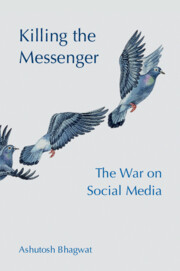Refine search
Actions for selected content:
101 results
7 - Privacy, Big Data, and Free Speech
-
- Book:
- Killing the Messenger
- Published online:
- 05 September 2025
- Print publication:
- 25 September 2025, pp 146-163
-
- Chapter
-
- You have access
- Open access
- HTML
- Export citation

Killing the Messenger
- The War on Social Media
-
- Published online:
- 05 September 2025
- Print publication:
- 25 September 2025
-
- Book
-
- You have access
- Open access
- Export citation
5 - Adult Culture Wars and Student Achievement
-
- Book:
- No Adult Left Behind
- Published online:
- 07 August 2025
- Print publication:
- 21 August 2025, pp 131-153
-
- Chapter
- Export citation
5 - The Freedom of Speech
-
- Book:
- The Changing Constitution
- Published online:
- 21 August 2025
- Print publication:
- 21 August 2025, pp 102-140
-
- Chapter
- Export citation
4 - ©ensored
-
- Book:
- The Secret Life of Copyright
- Published online:
- 08 August 2025
- Print publication:
- 14 August 2025, pp 140-170
-
- Chapter
- Export citation
5 - “Murder the Media”
- from Part II - Democracy and the Press Function
-
-
- Book:
- The Future of Press Freedom
- Published online:
- 25 July 2025
- Print publication:
- 24 July 2025, pp 52-64
-
- Chapter
-
- You have access
- Open access
- HTML
- Export citation
14 - The Long Shadow of Food Lion
- from Part IV - Legal Protection for the Press Function
-
-
- Book:
- The Future of Press Freedom
- Published online:
- 25 July 2025
- Print publication:
- 24 July 2025, pp 210-246
-
- Chapter
-
- You have access
- Open access
- HTML
- Export citation
6 - Branding Birth Control
-
- Book:
- Selling Sexual Knowledge
- Published online:
- 24 June 2025
- Print publication:
- 10 July 2025, pp 181-212
-
- Chapter
-
- You have access
- Open access
- HTML
- Export citation
10 - The Paradigm Shift from Formalism to Instrumentalism and Constitutional Law
-
- Book:
- After the Realist Revolution
- Published online:
- 02 May 2025
- Print publication:
- 22 May 2025, pp 121-147
-
- Chapter
- Export citation
Jailing Peace Protesters in Japan: Lessons from the “Tent Village” Case
-
- Journal:
- Asia-Pacific Journal / Volume 22 / Issue 8 / August 2024
- Published online by Cambridge University Press:
- 14 March 2025, e5
-
- Article
-
- You have access
- Open access
- Export citation
16 - The Right to Freedom of Thought in South Africa
- from Part IV - Africa
-
-
- Book:
- The Cambridge Handbook of the Right to Freedom of Thought
- Published online:
- 06 March 2025
- Print publication:
- 13 March 2025, pp 200-211
-
- Chapter
- Export citation
2 - The United States’ Approach to “Platform” Regulation
-
-
- Book:
- Defeating Disinformation
- Published online:
- 30 January 2025
- Print publication:
- 06 February 2025, pp 7-19
-
- Chapter
-
- You have access
- Open access
- HTML
- Export citation
14 - Platform Responsibility
-
-
- Book:
- Defeating Disinformation
- Published online:
- 30 January 2025
- Print publication:
- 06 February 2025, pp 220-246
-
- Chapter
-
- You have access
- Open access
- HTML
- Export citation
7 - The Fight against Disinformation in the Council of Europe, and the Relevant Case Law of the European Court of Human Rights
- from Part III - Regional Regulatory Approach to Disinformation: Europe
-
-
- Book:
- Disinformation, Misinformation, and Democracy
- Published online:
- 09 January 2025
- Print publication:
- 23 January 2025, pp 161-196
-
- Chapter
-
- You have access
- Open access
- HTML
- Export citation
11 - Disinformation, Misinformation and Democracy
- from Part IV - National Approaches to Disinformation
-
-
- Book:
- Disinformation, Misinformation, and Democracy
- Published online:
- 09 January 2025
- Print publication:
- 23 January 2025, pp 258-269
-
- Chapter
-
- You have access
- Open access
- HTML
- Export citation
Chapter 4 - Adjudication
-
- Book:
- The Quislings
- Published online:
- 12 December 2024
- Print publication:
- 19 December 2024, pp 147-189
-
- Chapter
- Export citation

Comedy and Controversy
- Scripting Public Speech
-
- Published online:
- 18 December 2024
- Print publication:
- 30 January 2025
-
- Element
- Export citation

The Quislings
- The Trials of Norwegian Wartime Collaborators, 1941–1964
-
- Published online:
- 12 December 2024
- Print publication:
- 19 December 2024
5 - Speech, Association, and Religion
- from Part II - Symmetry Applied
-
- Book:
- Constitutional Symmetry
- Published online:
- 14 November 2024
- Print publication:
- 21 November 2024, pp 115-144
-
- Chapter
- Export citation
